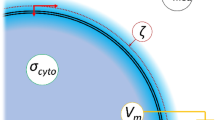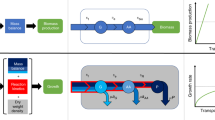Abstract
THE electric impedance of suspensions of yeast cells, suspended in solutions of electrolytes, has been measured as a resistance, R, and a parallel capacitance, C, with a Wheatstone bridge. In Fig. 1 are shown C and R, as functions of frequency, for a 63 per cent suspension of yeast cells in a 0.1 per cent sodium chloride solution. The form of the curve for C is interesting, particularly when it is compared with the curve usually obtained for tissues1, for it seems that it provides evidence regarding characteristics of the cell surface which may be obscured in the case of tissues by reason of their lack of homogeneity. For suspensions of red blood corpuscles, curves1 have been obtained similar to those for yeast, although the increase of C at low frequencies is of much smaller magnitude.
This is a preview of subscription content, access via your institution
Access options
Subscribe to this journal
Receive 51 print issues and online access
$199.00 per year
only $3.90 per issue
Buy this article
- Purchase on Springer Link
- Instant access to full article PDF
Prices may be subject to local taxes which are calculated during checkout
Similar content being viewed by others
References
H. Fricke, Cold Spring Harbor Symposia on Quantitative Biology, 1, 117; 1993.
H. Fricke and S. Morse, J. Gen. Physiol., 9, 137; 1925.
Author information
Authors and Affiliations
Rights and permissions
About this article
Cite this article
FRICKE, H., CURTIS, H. Electric Impedance of Suspensions of Yeast Cells. Nature 134, 102–103 (1934). https://doi.org/10.1038/134102b0
Issue Date:
DOI: https://doi.org/10.1038/134102b0
This article is cited by
-
Membrane Homeostasis: The Role of Actin Cytoskeleton
Journal of the Indian Institute of Science (2021)
-
Once upon a time the cell membranes: 175 years of cell boundary research
Biology Direct (2014)
-
Experimental and theoretical studies of the effect of electrode polarisation on capacitances of blood and potassium chloride solution
Medical & Biological Engineering & Computing (2002)
-
Passive electrical properties of Halobacterium species
Biophysics of Structure and Mechanism (1978)
-
Dielectric properties of yeast cells
The Journal of Membrane Biology (1976)
Comments
By submitting a comment you agree to abide by our Terms and Community Guidelines. If you find something abusive or that does not comply with our terms or guidelines please flag it as inappropriate.



